Most of us have heard of Angkor Wat and some of us know that the photographs that we usually see floating around the web masquerading as Angkor Wat photographs are not really those of the Angkor Wat. Some of the most popular photographs either have huge trees growing out of rock or gigantic faces.
If the photographs you are seeing feature trees growing out of rocks and walls, then it is Ta Prohm that you are seeing. And if it is the big faces then it is the incredible Bayon. Both these temples are in the list of Angkor temples but aren't a part of Angkor Wat.
Bayon is located in the Angkor Thom area and was built in the late 12th or early 13th century by the Mahayana Buddhist King Jayavarman VII. His Hindu and Theravada descendants made some modifications to the temple as per their own religions. However, the most striking feature of the temple, the countless, serene faces are still around.
These faces bear striking resemblance to a sculpture of King Jayavarman VII, and there are 216 of them. Scholars are divided in thinking whether these faces are representations of the King Jayavarman or the Bodhisattva of compassion. It may also be both, as Kings often believed themselves to be representatives / reincarnations of God.
From a distance the temple looks like a pile of rocks. It's only when you get up close that you start notice the detailing, including the giant faces. Smaller carvings are only visible when you are up close.
All through the Bayon complex, there are stairs running up and down. There are places where you can pose in a way that it appears that you are kissing the statues. The staff at Bayon will gladly help you identify these spots and even guide you how those pictures should be clicked.
Apart from the faces, there are several other spots in Bayon where you can click some excellent photographs. My nephew Nishu kept making us pose at such spots. This is one photograph in which we made him pose for us with is parents.
While some faces are fairly intact, others have eroded over centuries. Some of the best fridge magnets available in Cambodia are those of Bayon. You will find some that depict a face complete with its cracks and every other detail.
It is said that all of these faces have different expressions. To be honest, most of them seemed similar to me. But that may be because I do not have the skills to notice nuances in sculptures. The only thing I can say with confidence is that they are all beautiful and it is incredible how people managed to build such grand structures without modern technology.
You will find these bas reliefs at many places inside the temples. These are Apsaras or dancing nymphs. Cambodia has inherited these symbols from Hindu cultures and their significance is the same too. Today, inspired by these reliefs, many hotels organize something known as the Apsara dance and tourists often pay heavy ticket prices to watch these.
Similarly, lion as a protector of temples is also a concept that is inherited from Hinduism. According to Hindu scriptures, Brahma used lions as the guards to his palace. The fact that today in most Cambodian temples you will find a lion (a sculpture, of course) sitting at the entrance, is a definite indication that Hindu culture was a huge influence in this era.
We tried to capture the complete structure of Bayon. Unfortunately some restore work was going on in the temple and therefore you can see the green barricades. After Ta Prohm, Bayon was the most beautiful temple in Angkor Wat complex.
Related Blogposts -













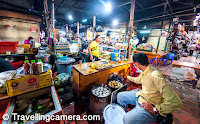


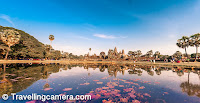
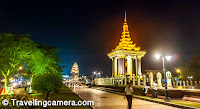


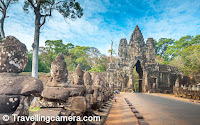
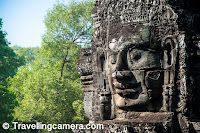

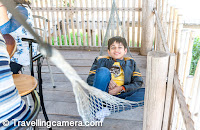




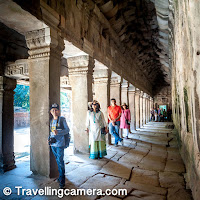

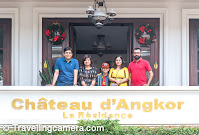


.jpg)
Comments